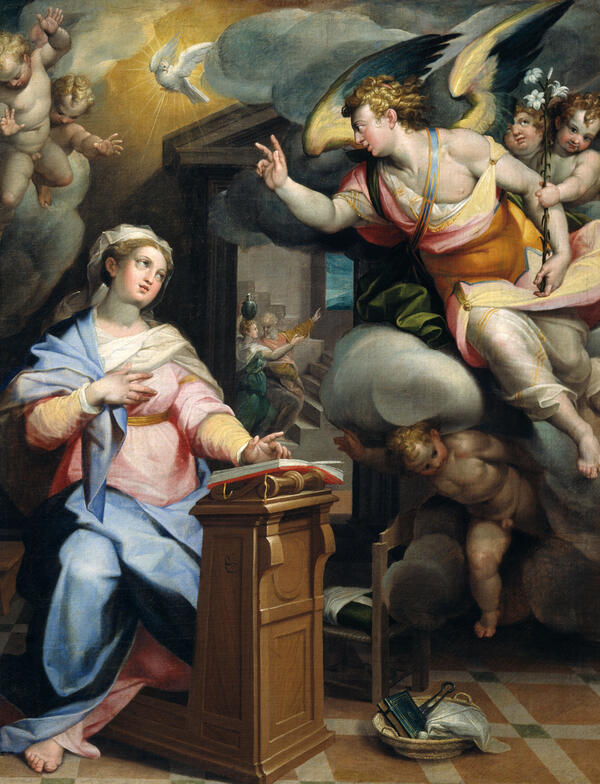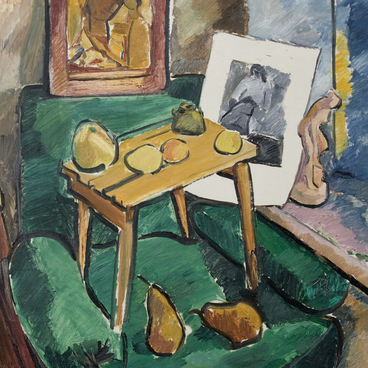The 16th-century Italian artist Orazio Sammacchini’s “Annunciation”, displayed in the Tula Museum exhibition, is the only work of this artist presented in Russia. Sammacchini was the leading master of Mannerism in Bologna. It is a transitional direction from Renaissance to Baroque, characterized by loss of harmonic clarity of the artistic language.
The Annunciation theme was prevalent in European art, especially with mannerists. It expressed the tragedy of their worldview, a sense of the vibrancy of human destiny, penetrated by heavenly will. On this canvas, the messenger of the Lord, Archangel Gabriel, surrounded by angels, seems to rush into Mary’s room, proclaiming the Good News to her: she is chosen to become the Mother of the Lord’s Son. The Virgin Mary’s gesture expresses the humbling acceptance of divine will and resignation to her destiny. Grace descends upon her: dove, the symbol of the Holy Spirit in Christian art, emanates the divine radiance, the rays of which will now touch Mary. A basket with a cloth and a ball of string at Mary’s feet symbolizes the “weaving” of the Savior’s flesh in the womb of the Mother of Lord. And the white lily in the hands of the angels is a symbol of holiness and purity of spiritual thoughts.
The artistic embodiment of this plot in Sammacchini’s work is disharmonious. The acutely dynamic composition is overloaded, devoid of classical equilibrium. Space is tight and compressed. Only in the doorway, it develops in-depth. Instead of sublime idealized images, powerful, heavyweight figures of characters are on the canvas. It seems that the angel can hardly hold the cloud on which Gabriel is sitting. Here, Sammacchiini is influenced by Giorgio Vasari, from whom many artists of that time adopted fascination with Michelangelo’s sculptural language.
The canvas’s composition is imbued with the depicted figures’ energetic movement — both the Archangel Gabriel and the Virgin Mary. Bright coloring, a contrast to cold and warm shade, complex positions of heroes — all this is typical for Mannerism. Breaking the canons established in Renaissance art and bringing in a biased beginning into their works. Mannerists expressed a biased idea of the impossibility of achieving harmony with the world.
The Annunciation theme was prevalent in European art, especially with mannerists. It expressed the tragedy of their worldview, a sense of the vibrancy of human destiny, penetrated by heavenly will. On this canvas, the messenger of the Lord, Archangel Gabriel, surrounded by angels, seems to rush into Mary’s room, proclaiming the Good News to her: she is chosen to become the Mother of the Lord’s Son. The Virgin Mary’s gesture expresses the humbling acceptance of divine will and resignation to her destiny. Grace descends upon her: dove, the symbol of the Holy Spirit in Christian art, emanates the divine radiance, the rays of which will now touch Mary. A basket with a cloth and a ball of string at Mary’s feet symbolizes the “weaving” of the Savior’s flesh in the womb of the Mother of Lord. And the white lily in the hands of the angels is a symbol of holiness and purity of spiritual thoughts.
The artistic embodiment of this plot in Sammacchini’s work is disharmonious. The acutely dynamic composition is overloaded, devoid of classical equilibrium. Space is tight and compressed. Only in the doorway, it develops in-depth. Instead of sublime idealized images, powerful, heavyweight figures of characters are on the canvas. It seems that the angel can hardly hold the cloud on which Gabriel is sitting. Here, Sammacchiini is influenced by Giorgio Vasari, from whom many artists of that time adopted fascination with Michelangelo’s sculptural language.
The canvas’s composition is imbued with the depicted figures’ energetic movement — both the Archangel Gabriel and the Virgin Mary. Bright coloring, a contrast to cold and warm shade, complex positions of heroes — all this is typical for Mannerism. Breaking the canons established in Renaissance art and bringing in a biased beginning into their works. Mannerists expressed a biased idea of the impossibility of achieving harmony with the world.



